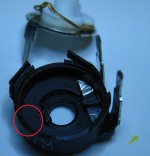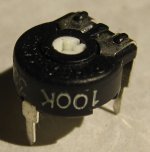Hello everyone. I have a doubt on the tone control pots of a Sansui A80. The cursor has no electrical connection when the pot is in the central position, but works well throughout the rest of the way. The 2 pots have the same behavior. This is good?. Thanks.
What symptoms led you to make this discovery/diagnosis? I am pretty sure it is not normal for the wiper to lose contact with the track near the center. The pots could be dirty though and appear to lose that connection at the setting they have spent the most time.
Funnily enough, the Baxandall that I just simulated will tolerate this just fine... you just lose a bit of low bass and output noise increases a bit.
If continuity between the ends is unaffected, it seems likely that the carbon track has become oxidized or oxide from the wiper has been deposited in its usual resting spot (maybe even silver migration?). Cleaning may be possible. Note that 100k reverse log pots do not exactly grow on trees, potential mechanical issues aside, so disassembly may be worth it (including the usual drilling out of rivets, which adds a certain fun factor).
If continuity between the ends is unaffected, it seems likely that the carbon track has become oxidized or oxide from the wiper has been deposited in its usual resting spot (maybe even silver migration?). Cleaning may be possible. Note that 100k reverse log pots do not exactly grow on trees, potential mechanical issues aside, so disassembly may be worth it (including the usual drilling out of rivets, which adds a certain fun factor).
Hi. I cleaned them with ultrasound, measured them after cleaning, not before. I am waiting for some components to arrive to finish the repair and to be able to test the equipment. If they are wrong, the problem will surely appear, (or not), if it appears, "I will have fun" punching rivets.😀
Hi. I cleaned them with ultrasound, measured them after cleaning, not before. I am waiting for some components to arrive to finish the repair and to be able to test the equipment. If they are wrong, the problem will surely appear, (or not), if it appears, "I will have fun" punching rivets.😀
Well, your idea of cleaning the tone control potentiometer with an ultrasonic cleaner did the damage that you are describing. The last location where the potentiometer’s wiper was set in this case the middle detent now has a void and permanently cleaned of the conductive carbon 😱
Well, your idea of cleaning the tone control potentiometer with an ultrasonic cleaner did the damage that you are describing. The last location where the potentiometer’s wiper was set in this case the middle detent now has a void and permanently cleaned of the conductive carbon 😱
Thank you, you have confirmed my suspicion, it was not a good idea to use an ultrasound cleaner for pots.🙁
The pot wiper heavily vibrating against the carbon track might well eliminate the carbon in that spot if the ultrasonic cleaning is overdone.
If so, opening and fixing the carbon track will be required. For what is likely to be a small spot, graphite (e.g. from a soft pencil) may be a good bet. It's a good opportunity to inspect all the parts anyway. Sealing of oxidation-prone surfaces can be done with a thin layer of vaseline if you don't have anything better, but keep it away from phenolic board like pots often use, so metal etc. only.
If so, opening and fixing the carbon track will be required. For what is likely to be a small spot, graphite (e.g. from a soft pencil) may be a good bet. It's a good opportunity to inspect all the parts anyway. Sealing of oxidation-prone surfaces can be done with a thin layer of vaseline if you don't have anything better, but keep it away from phenolic board like pots often use, so metal etc. only.
May I ask you why?...vaseline ... keep it away from phenolic board
Best regards!
I vaguely remembered something about phenolic not being too fond of petroleum-based products... but it seems it's mostly an issue for solvents, which can get absorbed into the material and contaminate it.
Disassemble one of the pots, attached some photos in which I see a bright insulating layer on top of the carbon track, it would seem that intentionally, there is no connection with the cursor in the center of the path. The resistance between ends is 100K. Sorry for the bad focus of the photos
Attachments
When installed, do they operator smoothly? Is there any kind of abrupt tonal change as you move the control off center? Maybe that *is* the way it is designed.
I'm about to try it, many things had to be repaired, when I do, I will comment on the result.For now, thank you all.
It actually makes quite a bit of sense to design it that way - this gives a reliable "dead zone" around the center detent with known-linear frequency response, without having to depend on the pot having the exact right value at that spot (tolerances in log pots are no trivial business).
Now I also remember the pot cleaning method of one guy who would use some household metal polish in his ultrasonic cleaning solution and apparently had good results doing so. Makes sense if you consider that it's usually a tarnished wiper.
Carbon pots, it seems, are more resilient to ultrasonic cleaning than one might think.
Now I also remember the pot cleaning method of one guy who would use some household metal polish in his ultrasonic cleaning solution and apparently had good results doing so. Makes sense if you consider that it's usually a tarnished wiper.
Carbon pots, it seems, are more resilient to ultrasonic cleaning than one might think.
Finally, it went on track as we say in this place in the world. Obviously, it is not a damage caused by washing with ultrasound, it is by design. There are no jumps, no strange noises, it works perfectly well. Every day you have something new.
Thank you for your support.
Thank you for your support.
Finally, it went on track as we say in this place in the world. Obviously, it is not a damage caused by washing with ultrasound, it is by design. There are no jumps, no strange noises, it works perfectly well. Every day you have something new.
Thank you for your support.
I wouldn't make any conclusion that ultrasonic cleaning won't damage potentiometers/trimpots. Your case is an exception given that the middle detent apparently doesn't have any carbon material that affects the operation. If you look under a low power microscope, the surface might not be that smooth.
In the name of science, I performed a little experiment. I subjected a new Piher 100k trimpot to ultrasonic cleaning. The wiper was set close to the middle and the cleaning solution was water and a little bit of dishwashing soap. The test ran for about 30 minutes or until the ultrasonic cleaner timed out.
After the test, it was clearly visible under a low power microscope that some physical damage are visible on both the carbon material and the metal area which are in contact with the wiper.
Some potentiometer/trimmer manufacturers explicitly warn about NOT using ultrasonic cleaning for some of their products. It makes sense that their warning should be followed.
Attachments
Last edited by a moderator:
Hi ej25. Totally according to your comments, I did not think well what could happen if I cleaned them with ultrasound, and this offline cursor reading in the center of the route led me to make the query and better rethink what I had done. I think I was lucky, maybe if I had left it longer it would have caused some irreversible damage.
- Home
- Amplifiers
- Solid State
- SANSUI A80 tone control problem?









